Y-12 Blog

Field Engineering Administrator Kaitlyn W. shares her thoughts on teamwork as part of a series of Y‑12 stories highlighting our Construction team.
The Y‑12er spotlight shines on one of our own, Field Engineering Administrator Kaitlyn W. It takes all Y‑12 employees to make the mission happen successfully and safely. All views and opinions are the employee’s own and do not necessarily reflect those of CNS.
A conversation with her dad placed Kaitlyn W. on the career path she is on today. As a girl, she had set her sights set on being a veterinarian.
“My dad is an electrician, and he pointed out that he thought I was very mechanically inclined,” she said. “He asked why I wasn’t pursuing engineering instead. That shifted my mindset of what I thought I was capable of and planted the seed of ‘I can do this.’”
Kaitlyn got involved with STEM (science, technology, engineering, and math) programs at school, where the knowledge of what she could do grew.
“These programs taught me STEM‑related career goals were achievable,” she said. “As an 8‑year‑old girl, I thought careers like this were something you only saw in the movies.”
Today, as a field engineering administrator in Construction, Kaitlyn said her engineering knowledge informs how she can best support field engineers. It also comes in handy for the work she does to help plan small engineering projects.
Kaitlyn also manages the General Services Administration fleet of vehicles for Construction, overseeing 68 vehicles for the group’s use.
“The vehicles are one more tool for our construction workers,” she said. “I help to make sure those tools are running properly and that each of our workers has the right tool for the job.”
One of the things Kaitlyn finds interesting about working at Y‑12 is the site’s rich history, which is sometimes unearthed during construction tasks. But she noted that even for those who may never find themselves in a construction zone, the imprint of the past is still very visible around the site.
“It’s fascinating that we have a lot of historical items preserved in places like New Hope Center and Alpha 3 (Building 9201‑03),” she said.
Another aspect of the site that stands out to Kaitlyn is the number of opportunities and services offered on site. “It’s interesting to see how Y‑12 functions like its own little town behind the blue line. Everything you need is here.”
How has working for CNS changed or reinforced your thoughts on our mission?
Construction literally lays the foundation for Y‑12. Without buildings, roads, electricity, machinery, equipment, etc., we wouldn’t be able to fulfill our mission.
What is your favorite aspect about your work environment?
My favorite aspect is the people. I am surrounded by people who feel like brothers, fathers, and grandfathers to me. It’s very unique to have the kind of work environment where you truly feel like a family.
Who in your life has inspired you the most and why?
The women in the Society of Women Engineers (SWE). SWE helps me get out into the engineering community and meet other professional women I wouldn’t otherwise have the chance to meet to talk about professional goals and ambitions. They all set a great example for me on what it means to break barriers and be proud of what you can do.
What is one thing your coworkers would be surprised to know about you?
My coworkers may be surprised to know that I can play five different instruments: clarinet, piano, baritone, mellophone, and guitar.
Why is teamwork an important aspect at Y‑12?
We are all pieces of a bigger puzzle. There isn’t a single project that comes through Construction that doesn’t have multiple disciplines involved. Craft, administrators, managers, field engineers — are all different and unique pieces of that puzzle. Without each of us working together in our different areas, we would not succeed.
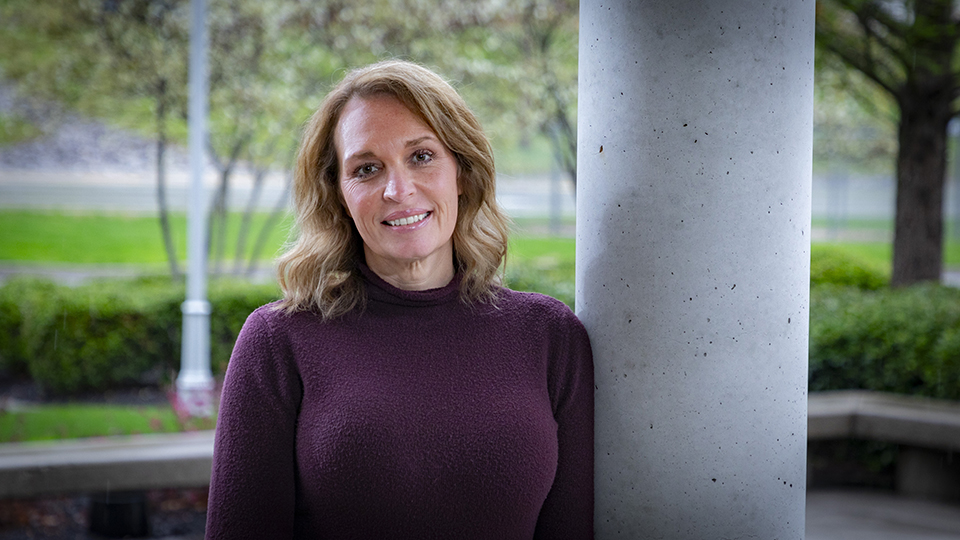
Leslie M. is set to take on her newest challenge at Y‑12. Photo by Brian Holt.
The Y‑12er spotlight shines on one of our own. It takes all Y‑12 employees to make the mission happen successfully and safely. All views and opinions are the employee’s own and do not necessarily reflect those of CNS.
Opportunity is found throughout the Y‑12 site. It’s something that Leslie M. has seen since she was hired in 2007 as an administrative assistant for what was then Business Development.
When she got the Y‑12 job offer, Leslie was working on her master’s degree in curriculum and instruction, coaching girls’ basketball (after playing at both Roane State Community
College in Harriman and Brevard College in North Carolina), and getting ready to begin student teaching. “I had wanted to get on at Y‑12 for a while, and I knew I could continue coaching basketball even if I didn’t teach, so I accepted the offer.” Since then, she has made an impact on several organizations throughout the site.
“I’ve been a program manager for work we did with the Department of Homeland Security, was the supervisor for shipping and the Production tool cribs, served as the conduct of operations representative for Fabrication, and was the Production security liaison for many years,” she said. “Each experience has reinforced just how crucial we are to national security. I have a greater appreciation for each part of our mission.”
As her roles at Y‑12 grew, she added to her education and completed the industrial engineering master’s degree program through CNS and the University of Tennessee. Her most recent role was Y‑12 Production Integration manager where her teaching/advising role helped her create an onboarding program for chemical operators. Now, she’s beginning a new phase as the Y‑12 master site planner, replacing Jane N. who has retired.
“This role offers a great opportunity,” she said. “As the site continues to grow, the master site plan has to support all needs — from infrastructure to parking. It’s a huge endeavor and an exciting time.” Soon, Leslie and her team will begin work on the FY 2026 Master Site Plan; the plan is updated every 2 years.
“We have to have a plan in place to ensure all aspects of our mission are accomplished. It is important to have a plan, and not one that only looks at now and 5 years out but also looks at 5 years and beyond. Those plans will inevitably change and shift, but at least there is a blueprint for future Y‑12ers to consider,” she said.
At a celebration for Jane, Leslie shared, “I have big feet, but in no way can I fill Jane’s role! I hope to develop the knowledge base she has of the Nuclear Security Enterprise.”
How has working for CNS changed or reinforced your thoughts on our mission (nuclear deterrence, managing the stockpile, etc.)?
I had very little knowledge about the Y‑12 mission before I started working here. With each phase of my career, I have grown a deeper understanding and appreciation for each facet of our mission. We have a great responsibility to our nation, and that is a humbling feeling.
What is your favorite aspect about your work environment?
My favorite aspect about my work environment is 100% the people. I have met so many wonderful and helpful people in 17 years. The one thing that stands out is how folks really rally behind each other in times of need. I saw the blessing of my work family during a family health scare earlier in my career. (See Leslie’s answer to who has inspired her.)
What work advice would you offer someone who is new to Y‑12?
Ask questions, never doubt yourself, and look for opportunities to advance your skill set!
What advice would you offer a newer employee about the importance of solving problems and asking questions?
Working at Y‑12 has its challenges, but it also has its rewards. There have been many days in my career that I have literally been putting a jig‑saw puzzle together [when responding to work assignments] only to get to the end and discover I am missing my last piece. In those moments, it is important to have your network — coworkers who you can reach out to for support, bounce questions off of each other, and depend on to give you constructive feedback. Without teamwork, you will be lost trying to find that last puzzle piece.
Who in your life has inspired you the most and why?
Over the past 16 years, this question has been easier to answer. It is my 16‑year‑old son. He was born with refractory epilepsy, which ultimately led to him having a radical brain surgery, an anatomical right hemispherectomy (removal of the right hemisphere, leaving only the left), at Cleveland Clinic in Ohio when he was 11 months old. This surgery resulted in him having cerebral palsy on the left side and loss of peripheral vision.
On a positive note, this surgery was a success, and my son has been seizure‑free for 16 years in May! He inspires me to be a better version of myself. He has never once said that his disabilities were an excuse. He is the most driven, determined, caring teenager, who is wise beyond his years! When my son sets his mind to something, he moves mountains to accomplish that goal. Watching him and seeing what all he has accomplished — I couldn’t be prouder.
In addition to my son, my daughter, who will soon be 19, has played an instrumental role in her brother’s life. She has been such a huge help and support with and for him. She does a great job of keeping me grounded too! Being their mom has honestly been the most rewarding job that I have and will ever have!
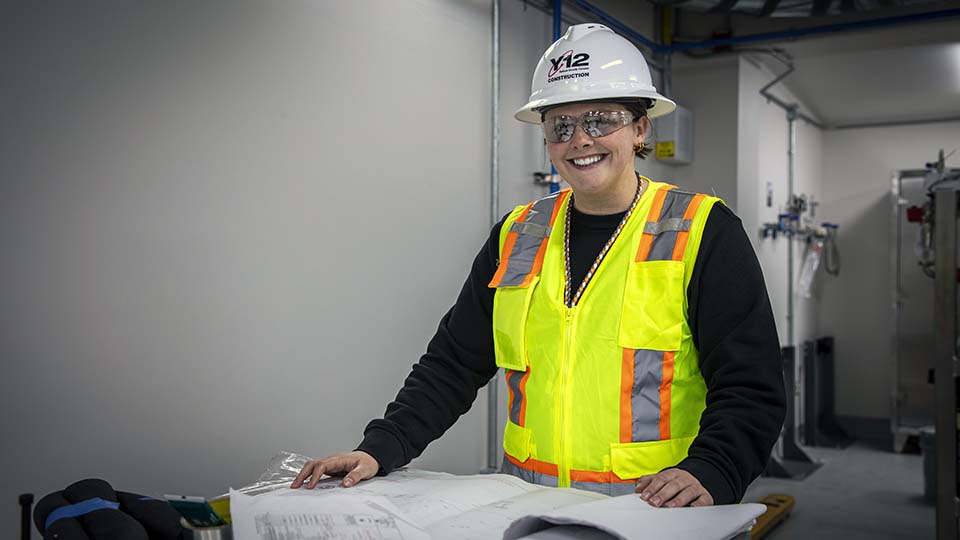
Photo: YPH‑25‑1196376.jpg Subcontract Technical Representative Jamie P. shares her thoughts on teamwork as part of a series of Y‑12 stories highlighting our Construction team.
The Y‑12er spotlight shines on one of our own, Jamie P., Y‑12 subcontract technical representative. It takes all Y‑12 employees to make the mission happen successfully and safely. All views and opinions are the employee’s own and do not necessarily reflect those of CNS.
When Jamie P. stepped into the area she was assigned to at Y‑12, she didn’t have to worry about decorating the walls, as they had been freshly torn down and rebuilt. Her assigned building had been gutted to studs and rebuilt from the floors up as part of a project renovating the facility for new mission work.
Jamie is a subcontract technical representative. STRs serve as the point of contact for subcontractors on‑site.
“My organization helps meet the mission by working with subcontractors to get facilities ready for occupancy. Moving people into a more modern facility helps ensure they can do their tasks efficiently,” she said. “And it improves safety, which is the site’s main priority.”
Jamie chose to work in the construction field because it interested her, especially because of the variety of different job fields under the construction banner. She particularly enjoys learning from other employees and understanding new approaches to the work.
“Construction involves constantly learning and growing as a person,” she said. “I like challenging myself and learning on the job, and at Y‑12, I am learning every day, including new systems and ways of doing work. For example, I learned how much goes into managing the lockout/tagout process, particularly how thorough it is and the steps Construction takes to notify multiple groups and coordinate each group’s response for the process.”
Jamie said what surprised her when she started at Y‑12 was how many construction projects are currently underway across the site. Work at Y‑12 and across the nation to modernize Nuclear Security Enterprise sites echoes the pace of work during the Manhattan Project era as construction teams work projects that will reduce risk, improve safety, and clear the way for future progress.
“Construction is directly supporting the mission by rehabbing old systems as well as building new [systems and facilities],” she said. “This is a fast‑paced environment.”
How has working for CNS changed or reinforced your thoughts on our mission (nuclear deterrence, managing the stockpile, etc.)?
Working for CNS has shown me our mission is more critical now than ever. It’s important that we meet our goals.
What is your favorite aspect about your work environment?
My favorite aspect about my work environment is the people I get to work with every day. They are great to work with and great teachers. Since I was hired on in September last year, I have been learning from my team about how the STR role works and how to run a project from start to finish.
What work advice would you offer someone who is new to Y‑12?
I would find a good mentor in your field and ask them a lot of questions. Asking questions helps in everything I do because I want to better understand what I am doing and why I am doing it that way.
What’s your favorite outside‑of‑work activity and why?
Going to the lake with my friends is my favorite activity outside of work. It’s relaxing.
How has teamwork allowed you to grow as an employee?
Teamwork has allowed me to grow by asking questions about the work and getting to know my coworkers. In Construction, you are always on a team, so teamwork is one of the biggest aspects in my field.
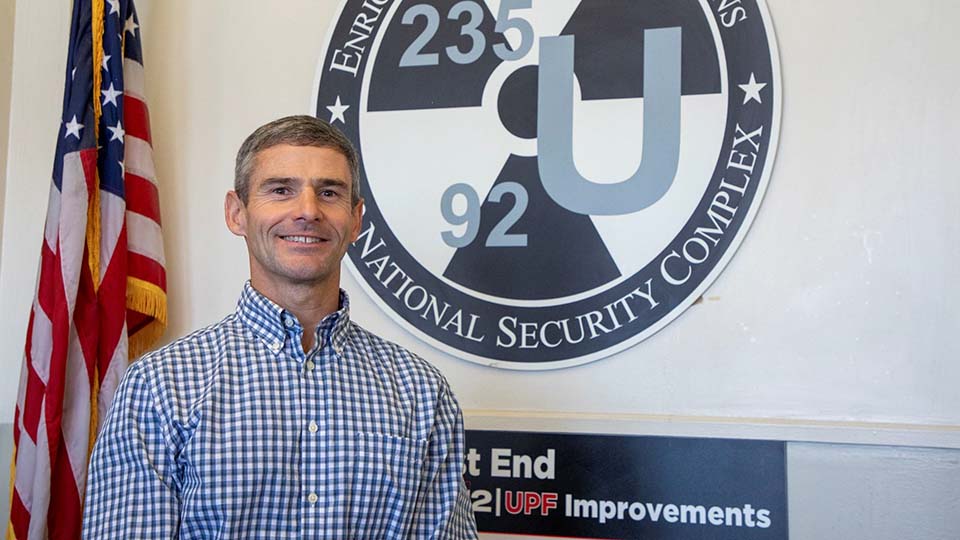
Eric H. began his Y‑12 career as a chemical operator in 2001, fresh out of community college.
The Y‑12er spotlight shines on one of our own, Eric H., deputy director of Enriched Uranium Operations. It takes all Y‑12 employees to make the mission happen successfully and safely. All views and opinions are the employee’s own and do not necessarily reflect those of CNS.
In 23 years at Y‑12, Eric H. has seen and done a lot.
“It’s been a great experience,” he said. “I’ve met a lot of people, and I’ve had the opportunity to be part of different processes and projects. It has been a pleasure to be here.”
He came to Y‑12 as a chemical operator in 2001 and followed that with various roles of increasing responsibility across the Operations organization. Today, he is deputy director of Enriched Uranium Operations. In that role, he assists and fills in for the EUO Director and manages approximately 260 production employees who process enriched uranium into a safe and compliant form for long-term storage, for disposition, or to meet various deliverables such as casting parts for weapons programs or supplying fuel to the nuclear navy, commercial and research reactors, and other customers.
“When I first got here as a chemical operator, I came from construction and agriculture,” Eric remembered. “I came in, got dressed out, and started learning the procedures. It was a challenge to adjust to the rigor and procedural compliance of the nuclear processes being done here.”
Fast forward a couples of decades: “I never would’ve imagined myself in this position. I never planned on being a leader of an organization.”
He came to Y‑12 not long after graduating with an associate’s degree in chemistry from Pellissippi State Technical Community College. He later earned a bachelor’s degree in Organizational Management from Tusculum College, while working at Y‑12.
His first impression of Y‑12 was a case of a dream clashing with reality.
“My vision of Y‑12 was that it was going to be this big high‑tech, spotless nuclear facility,” he said. “But in actuality, parts of the plant were old and dilapidated, two‑thirds of the equipment was not running, and there were many roof and process leaks throughout the work areas. I was not expecting that.”
Although an aging infrastructure can sometimes be a stumbling block, overcoming it is a source of pride for those working to achieve the mission in a challenging environment.
“We get it done, even with the old facilities,” Eric said. “We’re proud of that. There is pride in what we do here, pride in protecting the nation. I’m proud to work here because of the deterrent we are supporting. It’s helping to keep peace.”
How has working at CNS changed or reinforced your thoughts on our mission (nuclear deterrence, managing the stockpile, etc.)?
“Being here has definitely helped me hold a healthy respect for the nuclear industry and why we do this at Y‑12. Perceptions of what we do can keep adversaries from doing something wrong. There’s turbulence and instability across the world. There are countries who may consider launching a nuclear weapon, but then they look at the United States and our capabilities and think twice about it.”
Are you doing what you envisioned as a young adult?
“I envisioned my career to be more hands‑on, more technically oriented. I saw myself working in a lab or in a big chemical facility. Never saw myself assisting in the management of a team of 260 people who are doing the work I thought I might be doing. I’m surprised at where I started and where I am now.”
What’s your top bucket list item and why?
“I would like to visit all of the national parks throughout the U.S. I’ve been to several, like Yosemite and Sequoyah National Park out west. The United States is such a beautiful country. Going to the national parks is a great way to see it.”
We can often become overwhelmed at a work situation. Why is it important to remove yourself from a stressful situation? What advice do you offer to relax and decompress?
“It is extremely important to step away from a stressful situation to help make good decisions. We have to take stress breaks and decompress. For me, decompressing is doing something physical like mowing the yard or riding a bike through the woods. Once you clear your mind, you have a renewed perception and can come up with fresh and productive ideas.”
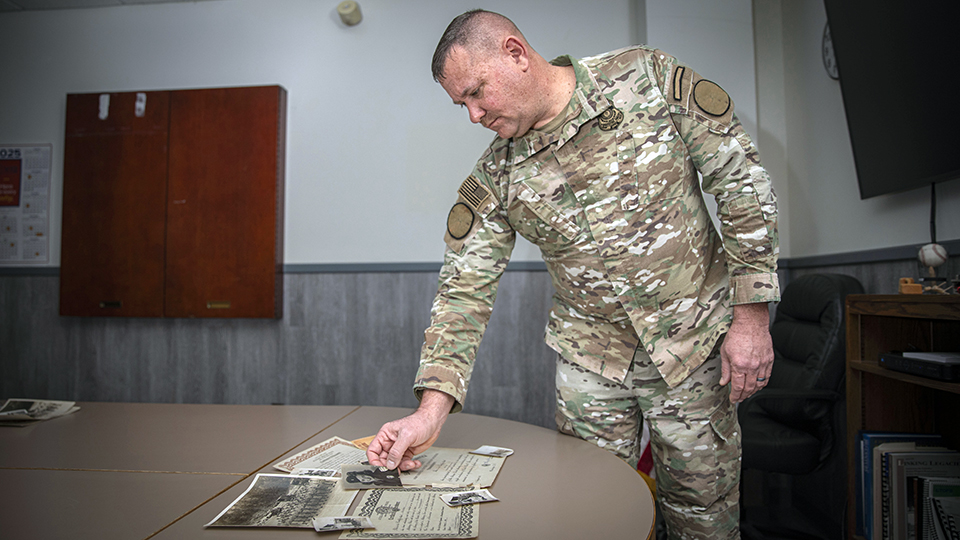
Matthew S. reflects on being in the same Protective Force as his Mamaw 80 years later.
When Matthew S. walked into a conference room to give a challenge coin to Director of Protective Force Operations and Training Sean K., he did not expect to see a photo of his grandmother on the wall. But there she was in black and white. The lady he affectionately called Mamaw passed away in 2000, but her time as a guard at Y‑12 still lives on through pictures — and through her grandson.
After retiring from his 20‑year career as a police officer and completing a degree in criminal justice at Bethel University, Matthew joined Y‑12’s Protective Force in 2020. Shortly after Sean K. was hired, Matthew remembers walking into the conference room with him and saying, “There’s my Mamaw,” while pointing out his grandmother in a photo featuring the Y‑12 Guard Department from 1945, which was displayed in the room.
Sean K., who was surprised an employee recognized someone from the Manhattan Project‑era photo, asked how Matthew knew, to which he responded he had seen the picture before in his grandmother’s picture book and could pick her out: front row, third from the left.
“I brought in pictures to show Sean featuring Mamaw and another woman — my great aunt Gladys, who also worked at Y‑12. Gladys was not a guard but worked on the site.”
Y‑12’s history is filled with fathers and sons, mothers and daughters, and a workforce that often spans generations among East Tennessee families. But the decades‑long link between Matthew and his grandmother stands out.
Mamaw’s actual name was Helen B. She joined the Auxiliary Military Police at Y‑12 — then known as Clinton Engineer Works — in September 1944. She first joined as a private and then received the rank of guard in January 1946.
“Mamaw did not tell me much about her time at Y‑12; she only mentioned working here a few times during my childhood,” Matthew said.
However, he knows that she was 21 when she was hired and that Y‑12 was the only place she ever worked. He also has memorabilia from her time working at the site, including her certificates of enrollment and photos of her in her uniform.
Helen is one of just nine women who are in the group picture from 1945. In commemoration of her service to the country, Helen received a certificate highlighting the importance of her work for the production of the atomic bomb and the successful conclusion of World War II.
The end of the war brought hope not only for the country and the world but also for Helen, who was waiting for her fiancé, Shelby C., to return from overseas.
When Matthew’s papaw [one of the troops that stormed the Normandy beaches] arrived home from World War II, Helen left work at Y‑12 to marry him and become Helen C. They went on to have four children, the eldest being Matthew’s mother.
“She was a very kind and loving woman,” Matthew said. “A good mother, grandmother, and a good provider. She went to church regularly. She basically raised me and my sister until we went to school.”
Matthew feels the connection to his grandmother is an important one. He did not anticipate ending up at Y‑12 in his career, but he said he is proud to be in the same place she was.
“I know she would be proud of where I am today,” Matthew said. “I wish she was alive to see me working here like she did.”
“What a legacy to be part of the same Protective Force your grandmother served in during the Manhattan Project. It shows that Y‑12 truly is a family environment that has fostered generations of dedication to our region and national security as a whole,” King said.
Matthew added, “Being in the same Protective Force 80 years later is somewhat overwhelming. In 1945, she probably never thought that in 2025, her grandson would be walking the same steps, going in some of the same places that she did. Although some of our job duties may differ now, the mission is still the same, and Y‑12 is still here.
“I’m proud to be here in the same division that she was, and I wouldn’t be alive and here today at Y‑12 had it not been for her.”
When asked what his favorite thing about being a Y‑12er was, he shared, “I feel appreciated here,” which is likely why the legacy of working at Y‑12 often spans generations.
As it turns out, the legacy Helen unknowingly left behind could continue through the next generation, as one of Matthew’s children graduates college in May and already wants to come to work at Y‑12 like his father and great‑grandmother before him.
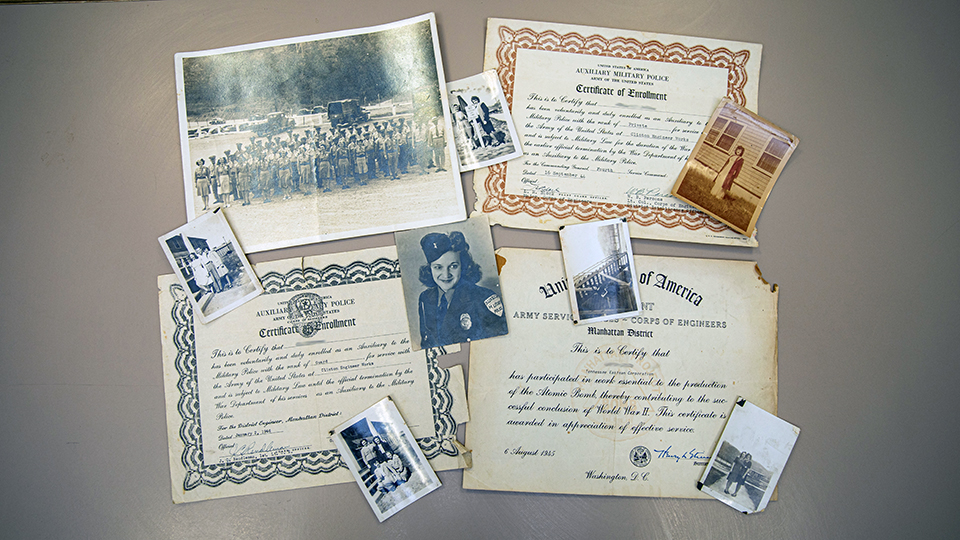
Among her personal memorabilia is the certificate highlighting the importance of Helen’s work for the production of the atomic bomb and the successful conclusion of World War II.
